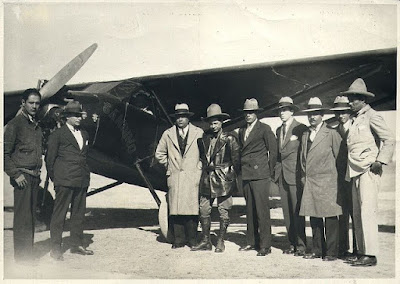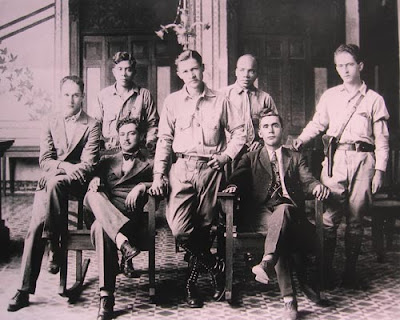Before the Revolution
The symbol and direct precedent of the revolution is the struggle of General Augusto C. Sandino (1895-1934), a national hero who fought with bravery, supported by an army formed by farmers and workers. He fought against the armed intervention of the United State in Nicaragua, done under the pretext of ensuring peace and democracy in the country.
After the Panama Canal was built, there was increased interest in Nicaragua by several countries for its potential as a site for a rival canal to Panama. The Marines has been sent to Nicaragua to in the early 1900’s to protect those interests. The Marines began to occupy Nicaragua, controlling Nicaragua’s gold mines and banks.
Sandino was the illegitimate son of a wealthy, Nicaragua land owner (who had an affair with Sandino’s mother, a farm worker on one of his properties). Sandino’s father never recognized him as his son, and Sandino grew up in the shadows of his older brother, who had access to the family business and was educated in the U.S. Working side by side his mother on his father’s farm, they were often only given food as compensation for their labor. When he was a teenager, Sandino decided to travel to Mexico to work.
In Mexico at that time, workers were beginning to organize, read about social movements and learn about worker’s rights. Sandino’s Mexican co-workers began to ask him why he was in Mexico when back in his homeland; the U.S. Marines were running his country. They called him a “vende patria” or sellout and told him to go back to Nicaragua and fight for his countries freedom
Sandino took this to heart. He returned to Nicaragua and began to work at one of the gold mines under Marine control. He proved to be an amazing leader and organizer. He began teaching other minors of his experiences in Mexico, about labor rights and social movements. He told them, this is our gold, this is our country, let’s fight to remove the Marines from Nicaragua.
Sandino fled the mines with other miners into the mountains and began to fight the marines. His “small and crazy army”, as the Chilean writer Gabriela Mistral called it, began fighting the US marines in the mountains of the Segovias, the northern part of the country. His tactics where so effective that even though they were outnumbered and even though the Marines were technologically superior, Sandinos army was never eliminated by foreign soldiers. Sandinos crazy army is often recognized as carrying out the first guerrilla warfare as they would fight the marines from behind and attack at night, the only way for them to be successful against the well armed Marines. The Marines finally left the country, leaving behind a Nicaraguan army that was then known as the National Guard (“Guardia National”), led by a national military man trained in the United States: Anastacio Somoza García, known as “Tacho”.
After the marines retreated, Sandino wanted to negotiate peace. There is a famous song in Nicaragua whose chorus states that Sandino loved his country so much he never wanted to be president. His only wish was for Nicaragua to be free.
Sandino was not only an amazing leader and general, he was also a visionary and had plans to live sustainably and create a community where his soldiers’ families would live communally off the land and carry out perm culture.
While he was worried about Somoza’s ties to the U.S., who supported him by training and arming the National Guard, Sandino was assured by President Jose Maria Moncada that Somoza would not have any power of the running of the country. Moncada set up a peace negotiating meeting with Sandinos. Sadly, Sandino who arrived at the meeting unarmed, was betrayed, captured and executed. Even now, the place where the body of this hero is buried remains unknown. Somoza then sent off members of his National Guard to massacre the villages where Sandino’s soldiers lived in the Segovias, killing all men, women and children.
With time and political astuteness Somoza García took power in 1937. His unconditional alliance with the United States (with whom he negotiated at the country’s expense) and his complete control of the National Guard guaranteed him his totalitarian “throne”, where contrarian politicians were controlled using terror methods and sometimes by massive executions. Nevertheless, in September 1956 Rigoberto López Pérez, a young poet from León, scarified his life when he shot the dictator during a social celebration that took place in the city of León. Rigoberto was killed at the same place. Somoza survived the bullets, but died later in a Panamanian hospital where he was transferred to.
Somoza García’s oldest son Luís Somoza then took over the presidency, while the National Guard was led by the youngest son, Anastacio Somoza Debayle, also known as “Tachito” (trained in the United States just like his father), who started a repression movement in León after his father’s death, against those who he considered political enemies.
In 1967 Luis Somoza Debayle was still occupying the presidency (although he did not govern for 11 years, he alternated power with another politician of that time), but suddenly died. After the government of a marionette president, “Tachito “, his younger brother won the national elections and restored the dictatorial repressive and devouring regime.
Even though his father had acquired various real estate properties, businesses and industries that then became his and his family’s patrimony, Somoza Debayle continued to indiscriminately collect more and more wealth. At the end of 1972, when a devastated earthquake hit Managua, a big part of foreign aid brought to Nicaragua was deviated to the dictator’s warehouse. This aid was commercialized and auctions put in place for the reconstruction of the city (paid by public money and international aid) were won by Somoza’s businesses and their allies.
The social distress was increasing, but the National Guard could strongly submit any public declaration by torturing and executing political opponents and people from the general population.



